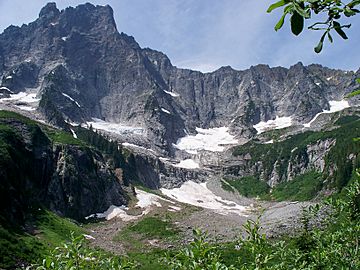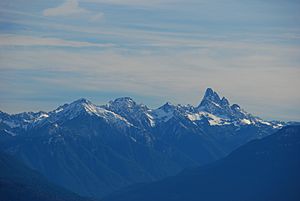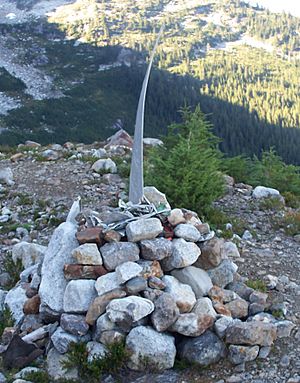Slesse Mountain facts for kids
Quick facts for kids Slesse Mountain |
|
|---|---|

Slesse Mountain in late July
|
|
| Highest point | |
| Elevation | 2,439 m (8,002 ft) |
| Prominence | 862 m (2,828 ft) |
| Geography | |
| Location | British Columbia, Canada |
| Parent range | Skagit Range, Cascade Mountains |
| Topo map | NTS 092.H.04 |
| Geology | |
| Mountain type | Intrusive |
| Volcanic arc/belt | Pemberton Volcanic Belt |
| Climbing | |
| First ascent | 1927 by Stan Henderson, Mills Winram, Fred Parkes |
| Easiest route | Southwest Route (Technical rock climb; Class 5.6) |
Slesse Mountain, often called Mount Slesse, is a tall mountain in British Columbia, Canada. It's located close to the border with the United States. This mountain is part of the Cascade Mountains, near the town of Chilliwack.
Slesse Mountain is known for its very steep sides. For example, its west face drops over 1,950 meters (6,400 feet) down to Slesse Creek. This happens in less than 3 kilometers (1.9 miles)! The mountain also has a huge feature called the Northeast Buttress, which is famous among climbers. The name "Slesse" means "fang" in the Halkomelem language. Other important mountains nearby include Mount Rexford and Canadian Border Peak in British Columbia. In the US state of Washington, you can find American Border Peak, Mount Shuksan, and Mount Baker.
How Slesse Mountain Was Formed
Most of Slesse Mountain is made of a type of rock called granite. This granite formed deep underground from melted rock (magma). It is part of a larger rock body called the Chilliwack batholith. This batholith pushed its way into the Earth's crust about 26 to 29 million years ago.
Slesse Mountain is also part of the Pemberton Volcanic Belt. This was once a chain of volcanoes that are now worn down. These volcanoes formed when one of Earth's plates, the Farallon Plate, slid underneath another plate. This process, called subduction, started about 29 million years ago.
The main rock you see on Slesse is a grey rock called diorite, which comes from the batholith. However, the very top ridge and the west side of the mountain are made of a different rock. This rock is called Darrington Phyllite. It's a metamorphic rock, which means it changed from one type of rock to another. This change happened because of the heat and pressure from the hot magma that formed the batholith.
Climbing History and Famous Routes
Mount Slesse was first climbed on August 10, 1927. The first climbers were Stan Henderson, Mills Winram, and Fred Parkes. They started their climb from Slesse Creek.
Today, the most common way to climb Slesse is called the Southwest Route. This climb involves going up about 1,650 meters (5,410 feet). It includes a lot of scrambling, which is like climbing over rocks using your hands and feet. There are also parts that need technical rock climbing, which means using ropes and special gear. These parts are rated up to class 5.6 in difficulty.
Slesse Mountain is most famous for its Northeast Buttress. This challenging route was first climbed on August 28, 1963. The climbers were Fred Beckey, Steve Marts, and Eric Bjornstad. It's a very serious rock climb that takes several days to complete. It's rated as a Grade V climb, with technical parts as hard as class 5.8 or 5.9. This climb is so well-known that it's featured in a famous climbing book called Fifty Classic Climbs of North America.
In July 1966, Hans Baer and Jack Bryan completed the second climb of this route. They spent one night on the mountain during their climb. Climbers from all over the world come to the Fraser Valley to try this amazing 24-pitch granite climb. It's one of the most iconic climbs in North America. While early climbs took many days, most modern climbers try to finish the route in a single day.
The 1956 Plane Crash
On December 9, 1956, a sad event happened on Mount Slesse. Trans-Canada Air Lines Flight 810, a North Star airplane, crashed on the upper slopes of the mountain. All 62 people on board died in the accident. At the time, it was one of the worst air disasters in the world.
Many of the people who died were team members from the Winnipeg Blue Bombers and Saskatchewan Roughriders football teams. They were flying home after playing an All-Star Game in Vancouver.
Today, there is a memorial for those who died on a road near the Chilliwack River. The crash site itself is a special place. Some human remains found after the crash were buried together in a common grave. Other remains found by climbers and hikers have been placed in a quiet, protected spot.
In the 1990s, the government passed a law to protect the crash site. This happened after a group called the Families of Slesse pushed for it. The site was in danger from logging at the time. Now, there are signs on trails leading to the site asking hikers and others to respect it.



